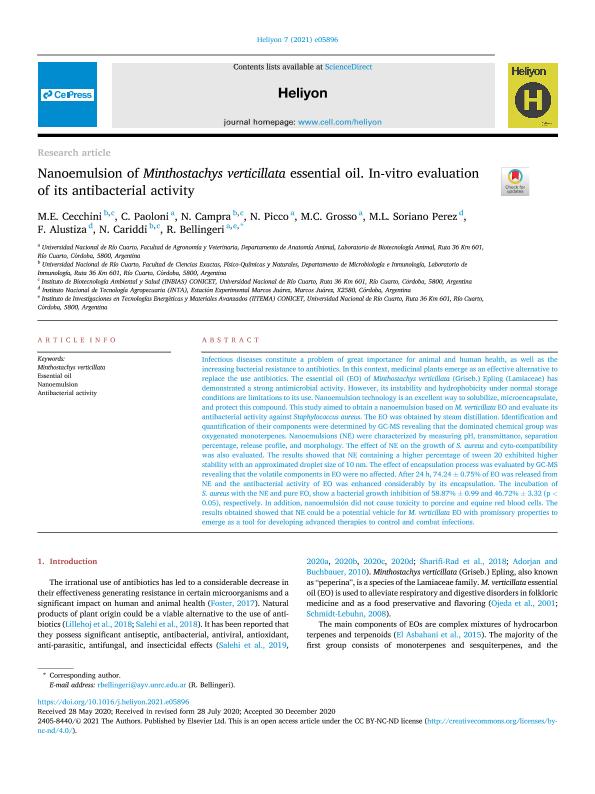Artículo
Nanoemulsion of Minthostachys verticillata essential oil: In-vitro evaluation of its antibacterial activity
Cecchini, Maria Eugenia ; Paoloni, C.; Campra, Noelia Anahí
; Paoloni, C.; Campra, Noelia Anahí ; Picco, Natalia Yanina
; Picco, Natalia Yanina ; Grosso, Maria Carolina
; Grosso, Maria Carolina ; Soriano Pérez, María Laura
; Soriano Pérez, María Laura ; Alustiza, Fabrisio Eduardo
; Alustiza, Fabrisio Eduardo ; Cariddi, Laura Noelia
; Cariddi, Laura Noelia ; Bellingeri, Romina Valeria
; Bellingeri, Romina Valeria
 ; Paoloni, C.; Campra, Noelia Anahí
; Paoloni, C.; Campra, Noelia Anahí ; Picco, Natalia Yanina
; Picco, Natalia Yanina ; Grosso, Maria Carolina
; Grosso, Maria Carolina ; Soriano Pérez, María Laura
; Soriano Pérez, María Laura ; Alustiza, Fabrisio Eduardo
; Alustiza, Fabrisio Eduardo ; Cariddi, Laura Noelia
; Cariddi, Laura Noelia ; Bellingeri, Romina Valeria
; Bellingeri, Romina Valeria
Fecha de publicación:
01/2021
Editorial:
Elsevier
Revista:
Heliyon
ISSN:
2405-8440
Idioma:
Inglés
Tipo de recurso:
Artículo publicado
Clasificación temática:
Resumen
Infectious diseases constitute a problem of great importance for animal and human health, as well as the increasing bacterial resistance to antibiotics. In this context, medicinal plants emerge as an effective alternative to replace the use antibiotics. The essential oil (EO) of Minthostachys verticillata (Griseb.) Epling (Lamiaceae) has demonstrated a strong antimicrobial activity. However, its instability and hydrophobicity under normal storage conditions are limitations to its use. Nanoemulsion technology is an excellent way to solubilize, microencapsulate, and protect this compound. This study aimed to obtain a nanoemulsion based on M. verticillata EO and evaluate its antibacterial activity against Staphylococcus aureus. The EO was obtained by steam distillation. Identification and quantification of their components were determined by GC-MS revealing that the dominated chemical group was oxygenated monoterpenes. Nanoemulsions (NE) were characterized by measuring pH, transmittance, separation percentage, release profile, and morphology. The effect of NE on the growth of S. aureus and cyto-compatibility was also evaluated. The results showed that NE containing a higher percentage of tween 20 exhibited higher stability with an approximated droplet size of 10 nm. The effect of encapsulation process was evaluated by GC-MS revealing that the volatile components in EO were no affected. After 24 h, 74.24 ± 0.75% of EO was released from NE and the antibacterial activity of EO was enhanced considerably by its encapsulation. The incubation of S. aureus with the NE and pure EO, show a bacterial growth inhibition of 58.87% ± 0.99 and 46.72% ± 3.32 (p < 0.05), respectively. In addition, nanoemulsión did not cause toxicity to porcine and equine red blood cells. The results obtained showed that NE could be a potential vehicle for M. verticillata EO with promissory properties to emerge as a tool for developing advanced therapies to control and combat infections.
Archivos asociados
Licencia
Identificadores
Colecciones
Articulos (IITEMA)
Articulos de INSTITUTO DE INVESTIGACIONES EN TECNOLOGIAS ENERGETICAS Y MATERIALES AVANZADOS
Articulos de INSTITUTO DE INVESTIGACIONES EN TECNOLOGIAS ENERGETICAS Y MATERIALES AVANZADOS
Articulos (INBIAS)
Articulos de INSTITUTO DE BIOTECNOLOGIA AMBIENTAL Y SALUD
Articulos de INSTITUTO DE BIOTECNOLOGIA AMBIENTAL Y SALUD
Articulos(CCT - CORDOBA)
Articulos de CTRO.CIENTIFICO TECNOL.CONICET - CORDOBA
Articulos de CTRO.CIENTIFICO TECNOL.CONICET - CORDOBA
Citación
Cecchini, Maria Eugenia; Paoloni, C.; Campra, Noelia Anahí; Picco, Natalia Yanina; Grosso, Maria Carolina; et al.; Nanoemulsion of Minthostachys verticillata essential oil: In-vitro evaluation of its antibacterial activity; Elsevier; Heliyon; 7; 1; 1-2021; 1-8
Compartir
Altmétricas



